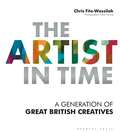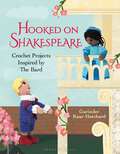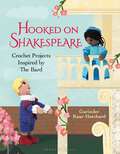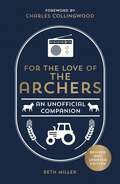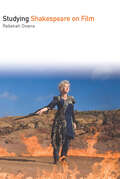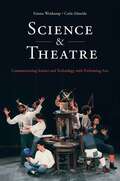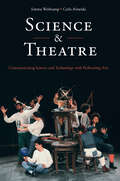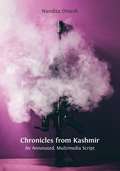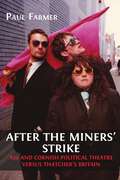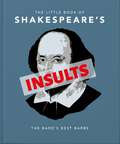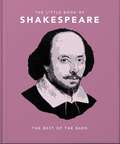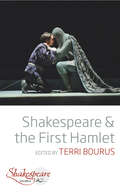- Table View
- List View
The Artist in Time: A Generation of Great British Creatives
by Chris Fite-WassilakThe Artist in Time brings together twenty creatives from across the UK, with photographs and interviews that disclose their daily working habits and motivations. All born before 1950, this is a collective portrait of a generation who have shaped our artistic landscape. They provide a range of different answers to the question 'what makes an artist?', and a set of insights into what makes up a creative life. Giving the reader access to the studio and working spaces of a diverse group of painters, poets, choreographers, filmmakers, illustrators, musicians, photographers, sculptors, writers and creators, The Artist in Time is a handbook for creativity and inspiration, made up of artists from all backgrounds who have all in their own way shaped, and continue to shape, the creative landscape of the United Kingdom.
Hooked on Shakespeare: Crochet Projects Inspired by The Bard (Hooked On...)
by Gurinder Kaur Hatchard15 projects featuring more than 30 step-by-step designs inspired by the works of William Shakespeare.This fabulous collection of creations ranges from the iconic Romeo and Juliet to Hamlet and the Ghost, and from the Three Witches from Macbeth to Bottom and Titania from A Midsummer Night's Dream. Not forgetting the one and only Woolliam Shakespeare himself.Each project features an introduction to the play and its characters, followed by colourful step-by-step instructions. The easy-to-make designs include fully illustrated stitch basics, perfect for beginning crocheters as well as advanced crochet enthusiasts.
Hooked on Shakespeare: Crochet Projects Inspired by The Bard (Hooked On...)
by Gurinder Kaur Hatchard15 projects featuring more than 30 step-by-step amigurumi inspired by the works of William Shakespeare.This fabulous collection of creations ranges from the iconic Romeo and Juliet to Hamlet and the Ghost, and from the Three Witches from Macbeth to Bottom and Titania from A Midsummer Night's Dream. Not forgetting the one and only Woolliam Shakespeare himself.Each project features an introduction to the play and its characters, followed by colourful step-by-step instructions. The easy-to-make designs include fully illustrated stitch basics, perfect for beginning crocheters as well as advanced crochet enthusiasts.
For the Love of The Archers: An Unofficial Companion: Revised and Updated
by Beth Miller Charles CollingwoodA revised and updated edition of the bestselling guide to all things Ambridge, For the Love of the Archers contains extensive all-new content that will keep any fan of the show enlightened and entertained.It’s been over 70 years since the familiar dum-di-dum-didum-di-dum of “Barwick Green” first brought The Archers to our airwaves, and in that time millions of listeners have followed the everyday lives of country folk in Ambridge.Bringing together a wealth of fascinating facts, amusing insights and expert trivia about characters, controversies and country customs in one handy volume – now fully revised and updated to include recent developments – this companion is the perfect gift for avid addicts and keen newcomers alike.Long-time Archers super-fan Beth Miller will be your highly engaging guide to every aspect of radio’s most enduring drama, including the following recurring features:Welcome to Ambridge takes you on a tour of all the key locationsMeet the Characters profiles all your favourite personalitiesMemorable Moments celebrates some of the most entertaining and emotional episodesGone But Not Forgotten remembers the dearly departedQuiz Night at the Bull tests your knowledge of the programme at regular intervalsFor all this and much more, dive into this incredible miscellany and become a true Ambridge expert.
Lorca: Blood Wedding (Aris & Phillips Hispanic Classics)
by Salvador Ortiz-CarboneresFederico Garcia Lorca was born near Granada in 1898. Initially set on studying music in Paris, after his piano teacher died in 1916 he became involved in a literary and artistic group, including H G Wells and Rudyard Kipling. This move towards a more literary life eventually paid off. Blood Wedding (Bodas de Sangre) was written in 1932, and was first performed in Madrid in March 1933. It proved to be the popular and critical success he'd been waiting for. When the play was staged in Buenos Aires he even found himself confronted with the prospect of wealth - a prospect that soon became a reality. This prosperous, happy spell was short-lived though, as the political situation in Spain altered under Franco, putting an end to this time, and ultimately, his life. Lorca was executed on August 18th 1936. Blood Wedding is based around the story of a young woman who, unable to wed her lover is made to marry a more suitable man. On the day of her wedding, however, La Novia (The Bride) runs away with her lover (Leonardo), who is married with children. A series of events ensues... Leonardo is the only character in the play to have a name, the others all being identified by their role: El Novio (The Groom), La Suegra (The Mother-in-Law). As with many of Lorca's plays, symbolism is key, with the moon and death personified. This is the first play in Lorca's trilogy of rural tragedies, with Yerma and The House of Bernarda Alba
Going Down to Morocco (Aris & Phillips Hispanic Classics)
by Jose Luis de SantosGoing Down to Morocco (Bajarse al moro), is one of the most emblematic and best known theatrical work of recent times in Spain. It both contributed to and documented La Movida, a drug-fuelled youth movement that placed Madrid firmly on the global cultural map in the early 1980s. Alonso de Santos' play, a commercial and critical success when first staged in 1985, was made into a film starring Antonio Banderas in 1989. Chusa, a free-spirited and spontaneously generous young drug smuggler introduces Elena, a middle-class runaway, to the apartment she shares with her cousin Pepito and her boyfriend Alberto, a rookie policeman. The result is chaos in their previously disorderly but happy life. The comedy explores opposing lifestyles of young people in 1980s Spain, during a period of radical social change. It is characterised by humour, creative use of contemporary slang, and intertextual film references. Duncan Wheeler's translation of the original play marks with footnotes the changes made in the new version done in 2008 for a high-profile revival to celebrate its twenty-fifth anniversary. This edition also includes an unpublished interview conducted by Duncan Wheeler with Alonso de Santos in 2010.
El muerto disimulado / Presumed Dead: Ângela de Azevedo (Aris & Phillips Hispanic Classics)
by Ângela de Azevedo Valerie HegstromThe Society for the Study of Early Modern Women and Gender awarded this work the Prize for the Best Translated Edition of a Work on Women and Gender, 2018.Valerie Hegstrom and Catherine Larson have created an annotated new edition and first-ever translation of Ângela de Azevedo’s vibrant comedy, El muerto disimulado / Presumed Dead, to promote the recuperation of early modern plays authored by women. The book contains a comprehensive introduction that describes Spanish theater in its Golden Age, what is known of the author’s life and times, contemporary stagings, and an extensive analysis of the text.Although the playwright penned her work in Spanish, the Portuguese Azevedo set the action in Lisbon, creating in the process an abundance of multicultural allusions that enrich the text’s baroque quality. The story unfolds as a cross between a jilted-lover scenario and a whodunit murder mystery. A woman laments her departed lover, a sister cross-dresses to avenge her murdered brother, a man duels with his cousin over lost honor, and before long, the dead man turns up as a ghost, or a bar maid, or a female peddler. Questions about identity abound in the witty El muerto disimulado / Presumed Dead. The transnational nature of this clever comedy complicates meanings, often producing bilingual wordplay that underscores the self-conscious, gender-bending, ludic character of the play and of theater in general. Azevedo highlights her ability to cross linguistic and geographic borders in the early modern period, as she simultaneously works within and offers a challenge to the dominant tradition of the Spanish Comedia.
The Force of Habit (Aris & Phillips Hispanic Classics)
Is gender learned or innate? This controversial play asks the question: what happens if you raise a boy to sew and behave as a girl, and raise his sister to fight as a soldier? For the first time ever, Guillén de Castro’s La fuerza de la costumbre (‘The Force of Habit’) will be available to English and Spanish audiences with a performance-tested translation on facing pages. Castro’s plot is unique in that, unlike other cross dressing plays, the children do not traverse gender boundaries by choice; instead complications arising from their parents’ problematic marriage dictate the gender they should perform. This new Spanish edition (the first since 1927) and performance-tested English translation will begin a new discussion of this understudied work and its implications among Hispanists, comparatists, performance theorists, and gender scholars. The critical apparatus includes a biography of the author, textual history, editorial methodology, metrical analysis, bibliography and notes on the text. Machit’s introductory essay, ‘Bad Habits: Gender Made and Remade in La fuerza de la costumbre’ aims to contextualize and investigate the most salient questions raised by Castro’s gender-bending play.
Studying Shakespeare on Film (Studying Films)
by Rebekah OwensAimed at newcomers to literature and film, this book is a guide for the analysis of Shakespeare on film. Starting with an introduction to the main challenge faced by any director—the early-modern language—there follows exemplars for examining how that challenge is met using as case studies twelve films most often used in classroom teaching, including Romeo and Juliet, Macbeth, and The Tempest.The first chapter explores how a director can tell the story in a setting that embraces the expectations of realism in cinema, but still pays homage to the theatrical origins of the work. The second chapter discusses films in which the setting provides a visual analogy with the preoccupations of the story, but not at the expense of Shakespeare's language. The third chapter extends this to show how some films use recent history as a setting, adding a further layer of meaning to the story from the cultural resonances associated with that historical past. These films also rely on an assumption that Shakespeare is so well-known as to form a distinctive, easily recognized brand in the cinema marketplace. Thus, his work can be reimagined in completely different genres such as those films that are the subject of the final chapter.
Lope de Vega: Fuente Ovejuna (Aris & Phillips Hispanic Classics)
Fuente Ovejuna (C.1613) is the most famous and frequently performed play by the creator of Spanish theatre, Lope de Vega (1562-1635). Astonishingly for its period, it celebrates the murder in 1476 of a nobleman, the Grand Commander of the Military Order of Calatrava, by the peasants he had oppressed, and their subsequent solidarity under torture. Fuente Ovejuna , however, is less a history lesson or political tract than an optimistic moral fable. Spanish text with facing-page translation, introduction and notes.
Calderon: The Schism in England: La cisma de Inglaterra (Aris & Phillips Hispanic Classics)
by Kenneth MuirAdmired by Shelley for 'its satisfying completeness', this thought-provoking and skilfully constructed play, which dramatizes the same subject as Shakespeare's Henry VIII , is one of its creator's most outstanding achievements. Understandably, Calderon offers an interpretation of King Henry's divorce from Catherine of Aragon and break with the Church of Rome which is markedly different from that given in Shakespeare's work. Yet, despite his Counter-Reformation allegiances, Calderon brings Henry VIII sympathetically to dramatic life. The schismatic English monarch is portrayed by the Roman Catholic Spanish playwright as a man endowed with moral awareness and with exceptional talent for spiritual leadership, who is, nevertheless, morally and spiritually destroyed by his extraordinary surrender to the forces of physical passion. In this first published translation of the play into English Kenneth Muir and Ann MacKenzie have adhered to methods effectively adopted in their previous books ( Four Comedies by Calderon, and Three Comedies by Calderon). They have composed, almost entirely in blank verse, an accurate yet elegantly poetic version, after the manner of the Elizabethans, but avoiding vocabulary which might seem affected to a modern audience, in order to produce a 'script' that could be performed with success on the stage. The critical edition, prepared by Ann Mackenzie to accompany the translation, is based on the editio princeps (published by Vera Tassis in Calderon's Octava parte de comedias [Madrid, 1684]). Her substantial Introduction and comprehensive Commentary together constitute the most detailed critical evaluation accomplished to date of this key-drama from the Golden Age in Spain. The Introduction, in particular, supplies new evidence as to the date of the play (1627) and the circumstances of its composition, and provides an analysis of Calderon's creative treatment of his historical source-work: Ribadeneyra's Historia eclesiastica del cisma del reino de Inglaterra (1588). Spanish text with facing-page translation, introduction and commentary .
Gil Vicente: Three Discovery Plays: Auto da Barca do Inferno, Exortacao da Guerra, Auto da India (Aris & Phillips Hispanic Classics)
by Anthony LappinThe three plays edited and translated in this volume are strongly linked to what we now think of as the Portuguese Discoveries. All three are fundamentally concerned with the expansion of Portugal in Africa and India through either crusade or commerce. In the introductions to the plays, the playwright's social role as a court dramatist is emphasized and his dramatic productions are set firmly within the political concerns of his time. Careful consideration is given to the involvement of both Gil Vicente and the Inquisition in the later emendation of the play's texts.
Macbeth (Devil's Advocates)
by Rebekah OwensWhy write about Roman Polanski's Macbeth (1971) as part of a series of books dedicated to the classics of the horror movie genre? Because, Rebekah Owens argues, just as Banquo in Polanski's film holds up a series of mirrors that reflect images of his successors that trace back to his own son Fleance, so subsequent milestones in the genre show their lineage to this work, their originator. Polanski had previously made Repulsion (1965) and Rosemary's Baby (1968), so he was fully aware of the conventions of the horror genre and this film provides clues to his own horror lexicon. This book demonstrates how Macbeth can be read as part of the British Folk tradition, strengthening the reading of the film as a horror movie in its own right through its links to The Wicker Man (1973), Blood on Satan's Claw (1971) and Witchfinder General (1968) then argues the case for its recognition as a horror movie even further, by connecting it to the later American horror classics, such as Halloween (1978). It also explores the popular associations made between the film and Polanski's own life, arguing that they endorse the view of the film as a horror. This book represents the first serious attempt to regard Polanski's Macbeth as a horror film in its own right, and not exclusively as one of a multitude of ongoing Shakespeare film adaptations.
Studying Shakespeare on Film (Studying Films)
by Rebekah OwensAimed at newcomers to literature and film, this book is a guide for the analysis of Shakespeare on film. Starting with an introduction to the main challenge faced by any director—the early-modern language—there follows exemplars for examining how that challenge is met using as case studies twelve films most often used in classroom teaching, including Romeo and Juliet, Macbeth, and The Tempest.The first chapter explores how a director can tell the story in a setting that embraces the expectations of realism in cinema, but still pays homage to the theatrical origins of the work. The second chapter discusses films in which the setting provides a visual analogy with the preoccupations of the story, but not at the expense of Shakespeare's language. The third chapter extends this to show how some films use recent history as a setting, adding a further layer of meaning to the story from the cultural resonances associated with that historical past. These films also rely on an assumption that Shakespeare is so well-known as to form a distinctive, easily recognized brand in the cinema marketplace. Thus, his work can be reimagined in completely different genres such as those films that are the subject of the final chapter.
Science & Theatre: Communicating Science and Technology with Performing Arts
by Emma Weitkamp Carla AlmeidaThere has been a significant growth in initiatives involving theatre, drama and performance within a science communication context. Yet there is little scholarship exploring this phenomenon from a science communication perspective. Weitkamp and Almeida draw on their distinct experiences with theatre in the context of science communication to delve into initiatives created through dialogue between the arts and the sciences for the purpose of public engagement. Entering into the space where museums, universities and research centres operate, as well as the space of theatre practitioners, they explore the richness and plurality of this universe, combining theory and practice, as well as presenting context, knowledge gaps and new data. Acknowledging that the place of drama, theatre and performance within science communication is one which is uniquely influenced by local cultural practices, discourses and expectations, the authors take a global perspective. Firstly by analysing data from an international survey of practitioners and secondly by curating a collection of case studies on science-theatre projects undertaken around the world. The chapters illustrate the diversity of forms and content that comprises contemporary science-theatre in this context and characterise theatre produced within the scope of science communication, placing it more precisely in the broader context of science-theatre.
Science & Theatre: Communicating Science and Technology with Performing Arts
by Emma Weitkamp Carla AlmeidaThere has been a significant growth in initiatives involving theatre, drama and performance within a science communication context. Yet there is little scholarship exploring this phenomenon from a science communication perspective. Weitkamp and Almeida draw on their distinct experiences with theatre in the context of science communication to delve into initiatives created through dialogue between the arts and the sciences for the purpose of public engagement. Entering into the space where museums, universities and research centres operate, as well as the space of theatre practitioners, they explore the richness and plurality of this universe, combining theory and practice, as well as presenting context, knowledge gaps and new data. Acknowledging that the place of drama, theatre and performance within science communication is one which is uniquely influenced by local cultural practices, discourses and expectations, the authors take a global perspective. Firstly by analysing data from an international survey of practitioners and secondly by curating a collection of case studies on science-theatre projects undertaken around the world. The chapters illustrate the diversity of forms and content that comprises contemporary science-theatre in this context and characterise theatre produced within the scope of science communication, placing it more precisely in the broader context of science-theatre.
Chronicles from Kashmir: An Annotated, Multimedia Script (Applied Theatre Praxis #2)
by Nandita DineshWhat is happening in Kashmir?’ Chronicles from Kashmir explores this question through a site-adaptive 24-hour theatrical performance. Developed between 2013 and 2018 by the Ensemble Kashmir Theatre Akademi and Nandita Dinesh, the play uses a durational, promenade format to immerse its audience within a multitude of perspectives on life in Kashmir. From a wedding celebration that is interrupted by curfew, to schoolboys divided by policing strategies, and soldiers struggling with a toxic mixture of boredom and trauma, Chronicles from Kashmir uses performance, installation and collaborative creation to grapple with Kashmir’s conflicts through the lenses of outsiders, insiders, and everyone in between. Due to varying degrees of censorship and suppression, the play has not been performed live since 2017. This book is, therefore, an attempt to keep Chronicles from Kashmir alive by including filmed scenes, a script, contextual questions, a glossary, and illuminating introductions by Nandita Dinesh and EKTA founder Bhawani Bashir Yasir. A valuable Open Access resource for practitioners, educators and students of performance and conflict, this book is also stimulating reading for anybody who has asked, ‘What is happening in Kashmir?’ This playscript includes: Twenty filmed scenes of the play in performance A range of contextual questions to stimulate discussion on staging site-adaptive theatre in places of conflict A helpful glossary
Performing Deception: Learning, Skill and the Art of Conjuring
by Brian RappertIn Performing Deception, Brian Rappert reconstructs the practice of entertainment magic by analysing it through the lens of perception, deception and learning, as he goes about studying conjuring himself. Through this novel meditation on reasoning and skill, Rappert elevates magic from the undertaking of mere trickery to an art that offers the basis for rethinking our possibilities for acting in the modern world. Performing Deception covers a wide range of theories in sociology, philosophy, psychology and elsewhere in order to offer a striking assessment of the way secrecy and deception are woven into social interactions, as well as the illusionary and paradoxical status of expertise.
Life, Re-Scaled: The Biological Imagination in Twenty-First-Century Literature and Performance
by Liliane Campos and Pierre-Louis PatoineThis edited volume explores new engagements with the life sciences in contemporary fiction, poetry, comics and performance. The gathered case studies investigate how recent creative work reframes the human within microscopic or macroscopic scales, from cellular biology to systems ecology, and engages with the ethical, philosophical, and political issues raised by the twenty-first century’s shifting views of life. The collection thus examines literature and performance as spaces that shape our contemporary biological imagination. Comprised of thirteen chapters by an international group of academics, Life, Re-Scaled: The Biological Imagination in Twenty-First-Century Literature and Performance engages with four main areas of biological study: ‘Invisible scales: cells, microbes and mycelium’, ‘Neuro-medical imaging and diagnosis’, ‘Pandemic imaginaries’, and ‘Ecological scales’. The authors examine these concepts in emerging forms such as plant theatre, climate change art, ecofiction and pandemic fiction, including the work of Jeff Vandermeer, Jon McGregor, Jeff Lemire, and Extinction Rebellion’s Red Rebel Brigade performances. This valuable resource moves beyond the biological paradigms that were central to the nineteenth and twentieth centuries, to outline the specificity of a contemporary imagination. Life, Re-Scaled is crucial reading for academics, scholars, and authors alike, as it proposes an unprecedented overview of the relationship between literature, performance and the life sciences in the twenty-first century.
After the Miners’ Strike A39 and Cornish Political Theatre versus Thatcher’s Britain: (pdf)
by Paul FarmerIn this rich memoir, the first of two volumes, Paul Farmer traces the story of A39, the Cornish political theatre group he co-founded and ran from the mid-1980s to the early 1990s. Farmer offers a unique insight into A39’s creation, operation, and artistic practice during a period of convulsive political and social change. The reader is plunged into the national miners’ strike and the collapse of Cornish tin mining, the impact of Thatcherism and ‘Reaganomics’, and the experience of touring Germany on the brink of reunification, alongside the influence on A39 of writers Bertolt Brecht, John McGrath and Keith Johnstone. Farmer, a former bus driver turned artistic director, details the theatre group’s inception and development as it fought to break down social barriers, attract audiences, and survive with little more than a beaten-up Renault 12, a photocopier and two second-hand stage lights at its disposal: the book traces the progress from these raw materials to the development of an integrated community theatre practice for Cornwall. Farmer’s candour and humour enliven this unique insight into 1980s theatre and politics. It will appeal to anyone with an interest in theatre history, life in Cornwall, and the relationship between performance and society during a turbulent era.
The Little Book of Shakespeare's Insults: Biting Barbs and Poisonous Put-Downs (The\little Book Of... Ser.)
by Orange Hippo!Away, you scullion, you rampallion, you fustilarian! Along with penning some of the most sublime passages in all of English Literature, Shakespeare was a master when it came to casting a wicked comeback or hurling a barbed insult. Whether it's Prospero calling Caliban a 'freckled whelp, hag-born' in The Tempest or King Lear railing against his daughter Goneril with the damning words, 'Thou art a boil, a plague sore, an embossed carbuncle in my corrupted blood', Shakespeare didn't hold back when it came to getting creative with his slights. Packed full of eloquent stings and poisonous putdowns, this is the perfect resource for anyone looking to scorn an enemy – without resorting to swearing! 'Away, you starvelling, you elf-skin, you dried neat's-tongue, bull's-pizzle, you stock-fish!' Henry IV Part I (Act 2, Scene 4). 'Away, you three-inch fool.' The Taming of the Shrew (Act 4, Scene 1). 'Go, prick thy face, and over-red thy fear, Thou lily-liver'd boy.' Macbeth (Act 5, Scene 3). 'The tartness of his face sours ripe grapes.' The Comedy of Errors (Act 5, Scene 4).
The Little Book of Shakespeare: Timeless Wit and Wisdom (The\little Book Of... Ser.)
by Orange Hippo!'He was "not of an age, but for all time".' (Shakespeare's contemporary Ben Jonson) No writer, before or since, has matched Shakespeare in terms of influence, critical acclaim or popular success. His genius lay in his sheer dramatic skill, his powerful use of imagery and his astonishing ability to create richly imagined characters. Packed full of the Bard's clever insights, witty asides and timeless nuggets of wisdom, and complemented by fascinating facts about his life and talents, this Little Book showcases some of the most remarkable lines ever crafted in the English language.SAMPLE QUOTES: 'What's in a name? That which we call a rose By any other word would smell as sweet.' - Romeo and Juliet, Act 2, Scene 2'We are such stuff as dreams are made on, and our little life is rounded with a sleep.' - The Tempest, Act 4, Scene 1'Cowards die many times before their deaths; The valiant never taste of death but once.' - Julius Caesar, Act 2, Scene 2SAMPLE FACT: There is evidence that Shakespeare wrote a play called Cardenio, which was performed by the King's Men in 1613. No known copy of the play exists today.
Shakespeare and the First Hamlet (Shakespeare & #9)
by Terri BourusThe first edition of Hamlet – often called ‘Q1’, shorthand for ‘first quarto’ – was published in 1603, in what we might regard as the early modern equivalent of a cheap paperback. Yet this early version of Shakespeare’s classic tragedy is becoming increasingly canonical, not because there is universal agreement about what it is or what it means, but because more and more Shakespearians agree that it is worth arguing about. The essays in this collected volume explore the ways in which we might approach Q1’s Hamlet, from performance to book history, from Shakespeare’s relationships with his contemporaries to the shape of his whole career.
You Wouldnt Want To Be Married To Henry Viii!
by Fiona Macdonald David AntramDivorced, beheaded, and died. Divorced, beheaded, survived! Uncover the secret lives of Henry VIII's ill-fated wives and what life was like as a Tudor queen. Henry VIII has asked for your hand in marriage, but marrying the King was no easy option. Henry VIII was a powerful, ruthless leader, with a track history of beheadings, adultery and scandal. Set against the turbulent backdrop of the Tudor court, this book explores Henry and his many wives - what went right, what went wrong, and what ultimately became of them all. With information on the church's break with Rome and the roles of key figures, such as Wolsey and Cranmer, this treacherous guide is the perfect curriculum companion to the Tudor period. The ever-popular You Wouldn't Want to Be series transports readers to the grisliest times and places in history, perfect for reluctant readers. The first-person narrative approach puts children in the shoes of some of the most unfortunate people ever to have lived.
La discreta enamorada / The Cleverest Girl in Madrid: Lope de Vega (Aris & Phillips Hispanic Classics)
This book is a Spanish/English edition of Lope de Vega’s La discreta enamorada. The core of the book consists of two texts: a critical edition of Lope’s play in Spanish and Donald R. Larson’s English translation/adaptation of that work. Common to the two texts are explanatory notes focusing on historical, cultural, and literary references. The Spanish text is further clarified by elucidations of difficult words or passages. The texts are preceded by a substantial introduction (discussing conventions of comedy, the comedia de capa y espada and its variation known as the comedia urbana, the political, social, and economic contexts of early 17th-century Madrid) and are followed by a critical apparatus that lists important variants that may be found in previous editions of Lope’s play.
